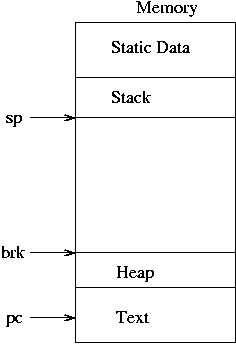





The brk point is just the name UNIX uses for the top of the heap. Also, text is just the program's code in machine language. Note that, while I've included arrows for the SP, PC, and brk on the memory drawing, the SP and PC are actually stored in registers and the brk in the PCB.
What happens when I request the shell create a mail(1) process? Under UNIX, two steps are required: first, the shell creates a copy of itself via the fork(2) syscall; then, this copy replaces itself with the mail program using the exec(3) syscall. Kind of strange, but it turns out to be quite useful.




Most fields of the PCB are copied from the original to the newly created PCB; they are starred and shown in blue above (we'll call the new process the child and the old the parent from now on). The memory is copied [2]; the mapping function is almost the same, but points to the copied memory. Note that the PC of the child process is at exactly the same address as the PC of the parent process. In fact, if we look at the instruction that the PC points to, we'll find that it's a syscall instruction (on x86, the actual assembly instruction is called int).
Recall that it is the kernel's job to schedule lots of different processes, giving each one some amount of processing time. These two processes are no different; eventually, the kernel will get around to running one of them (which one? that's undefined; either could run first). What will happen? The same thing that always happens when a process runs. It's registers are loaded onto the CPU, the kernel changes the CPU bit from protected mode to user mode, and starts processing at the PC.
Readers may have noticed a problem at this point. The processes are both exactly the same. If the kernel runs one, it'll do some stuff (whatever the instructions after the fork syscall instruction tell it to do). Then, when the other one runs, it'll do...the same thing. That's not too useful.
To get around this, we make the processes differ in a very slight but important way. The return value of the fork syscall will be 0 in the child process, and will be greater than zero in the parent (it actually happens to be the PID of the child in the parent). (Where is this return value? It might be in a register, it might be on the stack. That's yet another thing defined by the architecture.)
Thus, if we are clever, we'll put an if (pid > 0) statement right after our fork syscall, and do one thing in the child and a different thing in the parent. In the case of the shell, we'll see that the child calls exec(3) while the parent waits around for the child to finish.
exec first wipes out the mapping function for the process that called it, getting rid of all the memory. It then goes to the disk, and finds whatever program file was requested.
Executable files are stored on disk in some executable file format; Linux uses ELF, while other operating systems may use Mach.o, COFF, a.out, or other formats. They all have a very similar purpose, though: they tell the loader what to do. Specifically, the header of the file includes instructions for loading various bytes from the file into memory at different addresses, information about how to set up the mapping function, what the initial value of the PC should be, and some other information about what libraries should be loaded. And, of course, the executable file has to include the text (remember, text is code) of the program plus any static data (e.g. string constants) that it uses.
Once the loader has read its instructions from the executable file, it goes about setting everything up, copying the bytes from the file into memory. It probably needs to alter the mapping function to do this. But it doesn't alter most of the other fields in the PCB - this is important, because it means the process calling exec(3) (the child copy of the shell, in this case) can set things up if it wants to, possibly changing the open files or other PCB fields [3].
After setting up, the loader sets the initial state of the process (the register values) including the PC and SP. At this point we've still got two processes, but now one (the parent) is the shell, and the other (the child) is mail(1). The kernel can choose to run either of them, doing its normal job of making sure each one gets a bit of processing time. It is likely the case that the shell wants to wait for the mail (child) process to finish before doing anything else; it can tell the kernel this using the wait(2) syscall, which says that the process calling wait(2) doesn't want to run again until one of it's children finishes.
So that's the life cycle of a process on UNIX: clone, mutate, compute, die. Not a bad life for a process...
[2] Most modern systems do not actually copy all the memory when fork is called. Instead, they play a little trick to be lazy (remember, lazy is always good). They have the mapping functions for both the child and parent process point to the same memory until such time as one of them makes a change. Only when a change is made does the system copy the memory.
[3] The PCB is private to the kernel, so the shell couldn't actually directly set the values. It can, however, use a variety of syscalls to alter them in controlled ways.